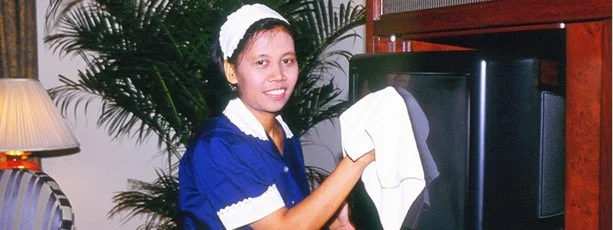1B. The Living Room And Bedroom
2024-03-04 16:00

Air-conditioner Maintenance
There are specific instructions by which your employers want their appliances to be handled and utilized. Try to understand and bear in mind your employers’’ instructions on the handling of electrical appliances. Write down these instructions so that you will not forget. Shut off air-conditioners in the morning after your employer has vacated the room for work or school. Keep the bedroom door closed to keep the cool air in. Keep the air-conditioners free from dust and accumulation of dirt by using a vacuum cleaner with a soft brush, rather than a damp cloth. So that its quality is maintained and to avoid damage and electric shocks.
Making the Bed
No one can sleep well in an unmade bed. The mattress should be clean and dry. The bottom sheet should be made carefully. The bed covers should be made with care, according to the preferences of your employers. Sheets and pillow cases should bechanged and laundered at least once a week.
Blankets should be washed or dry cleaned, usually in spring time or when the family is away. Change bed sheets, quilts or blankets, and pillow cases every week, or as your employer prefers. Families like to start off with clean sheets on Mondays. Others prefer the sheets to be changed the day before the domestic helper’s holiday so that the bed is well-made and fresh on her day-off.
Mattresses are subject to all sorts of stains that are hard to remove once they have seeped in or have dried. Mop up any damp stains with a cloth soaked in cold water. Dried blood can be rubbed off with a damp cloth left for a few minutes to loosen the stain.
A final light scrub with mild detergent and warm water removes residues of the stain. Towel the area dry and allow it to air dry. Do not use too much water. Stained sheets should be changed immediately.
Care of Furniture
Furniture needs careful dusting, especially at the legs of chairs and tables, at the back and seat of chairs, and corners that often get neglected. Vacuum sofas with a soft brush and remember to clean under loose cushions, where dirt can accumulate and children’s toys can get lost. Be careful not to hit the furniture or walls with the handle of your cleaning equipment or machine. Pay particular attention to carpet edges and borders where they join the walls. These are spots that collect dust and dirt.
Curtains and Carpet Cleaning
Draw the curtains open each morning, and open the windows when the occupant has vacated the room. Dust or vacuum the curtains as they collect dust and dirt.
Carpets need regular vacuuming to remove dirt. Be careful with the wheels or the edge of the vacuum cleaner, so that you do notdamage the floorboard skirting, chip off the varnish or paint. Candle wax and grease can often be removed by pressing it with a warm iron over several layers of paper napkin. Ink needs quick action to keep from blotting. Use lukewarm water and a very mild bleach solution over the ink drop. Be careful not to further spread the ink to other parts of the carpet.
Windows Cleaning
Windows are as important as beds and curtains. They have to be cleaned once a week or twice a month. Use a soft cloth to clean the windows and a dry cloth for finishing touches. Do not wait for your employer to tell you to do so.
Ceilings and Floors Cleaning
Ceilings are often forgotten. They require soft dusting with a spaghetti string mop or long-handled soft brush, particularly at the corners where there may be cobwebs.
Floors need constant cleaning. Mop up wet areas before they get stepped on. Always vacuum or sweep the floors first to clear the floor of large particles before cleaning and polishing the floor. Start washing and polishing the floor area from the cleanest to the least clean portion of the house i.e., from the bedroom to the living room area, kitchen and finally, to the bathroom. In the bathroom, start from the inner area and progress towards the door. Keep a special floor cloth to wipe any spills between washing. Do not use the same floor cloth for cleaning the kitchen area and other areas. Neither should you use rags for table tops for the floor. Floor rags and mops should be used exclusively for the floor.
Jika anda memiliki pertanyaan, harap tinggalkan pesan di halaman Facebook kami dan kami akan segera membalas persan anda
Kung mayroon po kayong mga katanungan, maari po na mag-iwan ng mensahe sa aming Facebook para po sa iba pang katanungan
Back : Book Index > Book Sub-Index
Previous Post : 1A. Working Routine | Next Post : 1C. The Bathroom and Washroom
![]()




